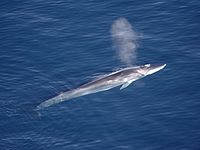
Photo from wikipedia
Seasonal feeding behaviour of humpback whales (Megaptera novaeangliae) has been observed in the coastal waters of the Southern Benguela where the species has been observed forming super-groups during the austral… Click to show full abstract
Seasonal feeding behaviour of humpback whales (Megaptera novaeangliae) has been observed in the coastal waters of the Southern Benguela where the species has been observed forming super-groups during the austral spring in recent years since 2011. Super-groups are unprecedented densely-packed aggregations of between 20 and 200 individuals in low-latitude waters and their occurrences indicate possible changes in feeding behaviour of the species. We accessed published data on super-groups occurrence in the study area in 2011, 2014 and 2015, and investigated oceanographic drivers that support prey availability in this region. We found that enhanced primary production is a necessary but not sufficient condition for super-groups to occur. Positive chlorophyll anomalies occurring one month prior to the super-group occurrences were identified, but only a concurrent significantly reduced water volume export from the region throughout October were conducive to the aggregations in the specific years. Hydrodynamic model results attributed the anomalous decreased volume export to the strength and orientation of the Goodhope Jet and associated eddy activity. The combination of random enhanced primary production typical of the region and emerging anomalous conditions of reduced water export in October since 2011 resulted in favourable food availability leading to the unique humpback whale aggregations. The novelty of this grouping behaviour is indicative of the lack of such oceanographic conditions in the past. Given the recency of the events, it is difficult to attribute this reduction in ocean transport to climatic regime shifts, and the origin should be likely investigated in the distant water mass interaction with the greater Agulhas system rather than in local intensifications of the upwelling conditions. A positive trend in the humpback whale population abundance points to the need to monitor the exposure of the species to the changing climate conditions.
Journal Title: Scientific Reports
Year Published: 2021
Link to full text (if available)
Share on Social Media: Sign Up to like & get
recommendations!